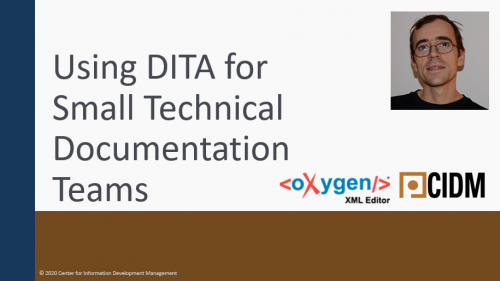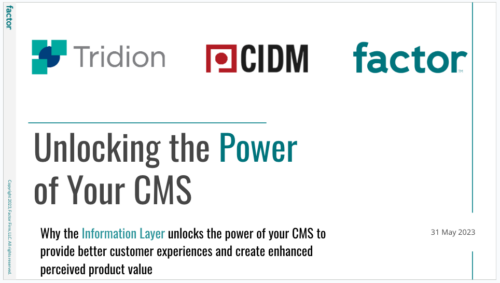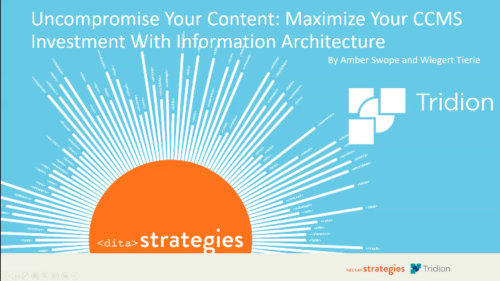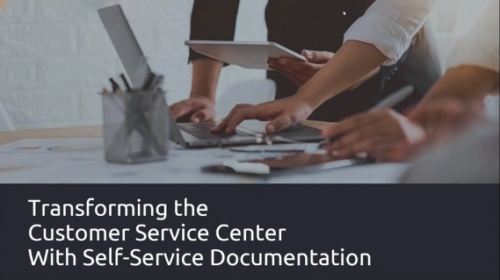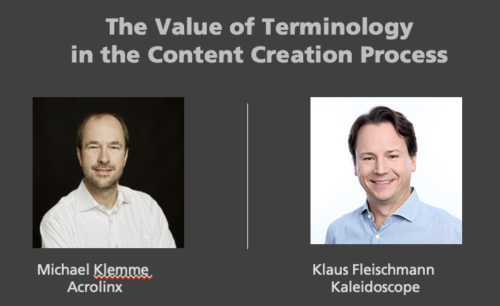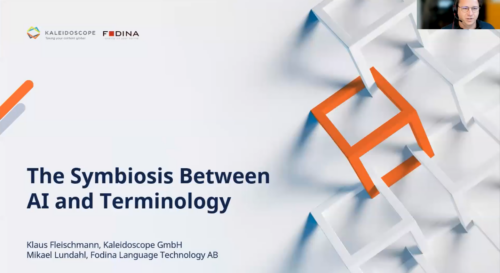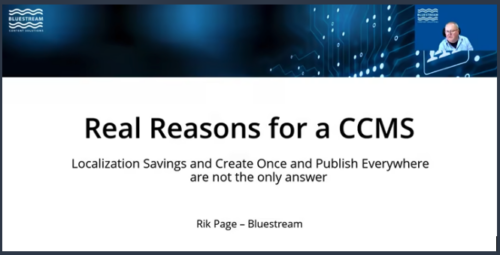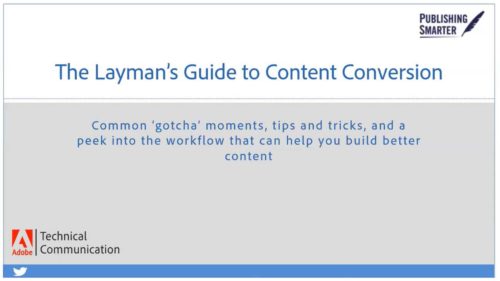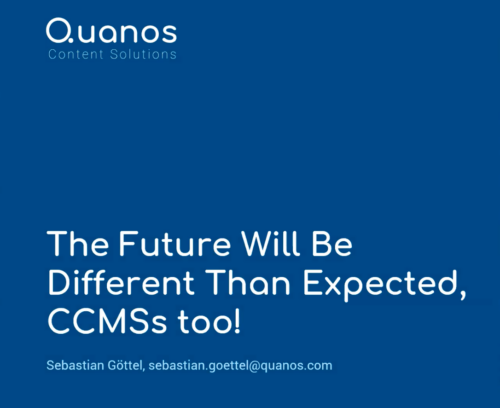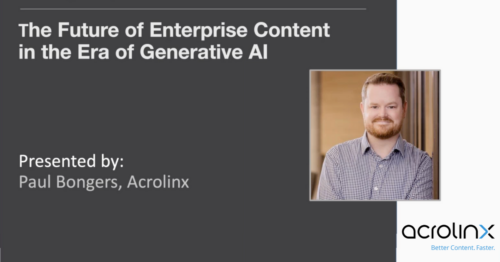-
April 1, 2020 Implementing DITA with a small team of technical writers does not have to be expensive or difficult to set up. We'll go through the steps of implementing a DITA solution using GitHub for storage and workflow and Oxygen XML Editor for editing. We'll also look into how you can automate publishing and receive feedback from your end users. As a practical example we'll look into how editing, collaboration and publishing on the Oxygen XML Blog works. Presented by: Radu Coravu started working more than 10 years ago as a software developer for Syncro Soft SRL, the manufacturer of the popular oXygen XML Editor. During the last years, his main focus has been in the development of the visual XML Author editing environment and the specific-DITA support provided by oXygen. He provides support for complex integrations and helps steer the product in the right direction, all this with some development on the side.
-
Recorded on December 6, 2023
 Join us for an exciting journey into editorial efficiency with our industry wizards. We’ll unveil the secrets to success throughout your editorial process, especially in a world where Generative AI has become a transformative force in content creation. In this dynamic session, we’ll explore the following fundamental points:
Join us for an exciting journey into editorial efficiency with our industry wizards. We’ll unveil the secrets to success throughout your editorial process, especially in a world where Generative AI has become a transformative force in content creation. In this dynamic session, we’ll explore the following fundamental points:
- How to streamline editorial processes to increase efficiency.
- Why governance is an essential factor in mitigating the risk of using generative AI for content creation.
- How to establish automated quality gates throughout the content supply chain.

 Peter Tauter, our Vice President of Product Management, is a seasoned professional with a background in computational linguistics, AI, and computer science. With 20+ years in B2B software development and product management, Peter is passionate about technology and how it can improve lives.
Peter Tauter, our Vice President of Product Management, is a seasoned professional with a background in computational linguistics, AI, and computer science. With 20+ years in B2B software development and product management, Peter is passionate about technology and how it can improve lives.
His expertise as an engineer and product strategist is evident in his track record of creating impactful solutions that benefit both businesses and individuals. Peter's commitment to innovation and user-centric technology is a driving force in our organization. Beyond the boardroom, he brings a unique touch of joy – not only can he lead in product creation, but he can also lead on the dance floor, mastering the art of a swing out.
-
Recorded on May 31, 2023

Why cultivating your Information Layer leads to better customer experiences and creates enhanced perceived product value.
In this Webinar, we’ll give attendees insight into what it means to manage and govern an enterprise content ecosystem by “unlocking” the power of the CMS. We’ll walk through case studies and examples of how successful organizations have extracted more value from their content and data. We’ll also give attendees hands-on exposure to the information layer by guiding interactive exercises in organizational alignment and modeling enterprise content taxonomies and metadata.
Presented by:
 Chip Gettinger is the VP of Global Solutions Consulting at RWS, he manages a team that works with customers in maximizing global content with RWS. He has experience working with customers to develop global content strategies, business ROI adoption drivers, change management, and technology adoption for component content management systems. He speaks and blogs about customer successes working closely with industry standards, partners, and customers in technology solutions and deployments.
with guests Bram Wessel and Bob Kasenchak, Factor Firm
Chip Gettinger is the VP of Global Solutions Consulting at RWS, he manages a team that works with customers in maximizing global content with RWS. He has experience working with customers to develop global content strategies, business ROI adoption drivers, change management, and technology adoption for component content management systems. He speaks and blogs about customer successes working closely with industry standards, partners, and customers in technology solutions and deployments.
with guests Bram Wessel and Bob Kasenchak, Factor Firm
 With more than two decades as a user-centered design and research professional, Bram Wessel believes that technology should enable natural experiences for real people. Bram has developed human-centered digital experience designs and strategies for such high-impact brands as Adobe, Amazon, Backcountry, the City of Seattle, Crate & Barrel, Disney, Expedia, GE, Group Health, Intel, Lionsgate, MasterCard, Microsoft, Nordstrom, Real, Safeco, Sony, Starbucks, Volvo, UW Medicine, and Warner Brothers.
A tireless advocate for the IA/UX discipline, with many articles to his credit, Bram is a frequent speaker at conferences such as the Information Architecture Summit, UX Week, Lavacon, Webvisions, ConveyUX, Seattle Design Festival, Taxonomy Bootcamp, and regional meetups and workshops. He is committed to educating the next generation of practitioners through his advanced User Experience and certificate Information Architecture classes at the School of Visual Concepts and as a guest lecturer at the University of Washington’s MCDM and MLIS programs.
Bram is a member of the Information Architecture Institute (IAI) and the Seattle chapter of the international Interaction Design Association (IxDA). Bram is a founding partner at Factor. In his spare time, Bram enjoys fly-fishing. shellfish farming, and making wine.
With more than two decades as a user-centered design and research professional, Bram Wessel believes that technology should enable natural experiences for real people. Bram has developed human-centered digital experience designs and strategies for such high-impact brands as Adobe, Amazon, Backcountry, the City of Seattle, Crate & Barrel, Disney, Expedia, GE, Group Health, Intel, Lionsgate, MasterCard, Microsoft, Nordstrom, Real, Safeco, Sony, Starbucks, Volvo, UW Medicine, and Warner Brothers.
A tireless advocate for the IA/UX discipline, with many articles to his credit, Bram is a frequent speaker at conferences such as the Information Architecture Summit, UX Week, Lavacon, Webvisions, ConveyUX, Seattle Design Festival, Taxonomy Bootcamp, and regional meetups and workshops. He is committed to educating the next generation of practitioners through his advanced User Experience and certificate Information Architecture classes at the School of Visual Concepts and as a guest lecturer at the University of Washington’s MCDM and MLIS programs.
Bram is a member of the Information Architecture Institute (IAI) and the Seattle chapter of the international Interaction Design Association (IxDA). Bram is a founding partner at Factor. In his spare time, Bram enjoys fly-fishing. shellfish farming, and making wine.
Bob is a taxonomist and ontologist with an interest in knowledge graphs and Linked Data. He has worked for over a decade building and implementing taxonomy projects for publishing, enterprise, technology, and e-commerce clients. He brings experience with information modeling and semantic software to client-focused metadata and vocabulary projects. Bob holds an MM in Theoretical Studies from the New England Conservatory of Music and a BA in Liberal Arts from St. John’s College, Santa Fe; he put in 5 years towards a PhD in Music Theory at the University of Texas before abandoning academia for the information industry. A frequent writer and presenter on semantic topics in conferences and journals, Bob’s current research interests include ontologies, knowledge graphs, and text classification. Still active teaching and playing music, Bob has been a member of the local ensemble Gamelan Encantada for the past several years. He lives in Albuquerque with his wife and elderly cat.
-
Recorded on January 12, 2023

Is your content CCMS-ready? Have you optimized your content versioning and lifecycle management? If you want to fully leverage your CCMS features, it’s time to update your IA.
In this webinar, Amber Swope, Information Architect at DITA Strategies, and Wiegert Tierie, VP of Strategic Accounts at RWS, share tools for transforming authored content so that it is CMS ready. Learn how to evaluate your map structures, topic structures, metadata, and content reuse strategies.
Presented by:
Wiegert Tierie, Vice President of Strategic Accounts and Tridion America Sales Team Lead, brings over 25 years of experience in numerous senior leadership roles. He is an ambitious visionary executive that uniquely combines strategy, sales, and marketing experience with an extensive background in financial, business process optimization, and product management to offer our customers a competitive edge, building their brand and their go-to-market strategy. To deliver results and success for the key customers he works with. Earlier Wiegert worked with Tridion, the leading Dutch Customer Experience and WCM vendor, and successfully launched numerous projects with Marquee brands. Prior to that, he played a key role in the introduction of Adobe Acrobat in Europe. Wiegert earned a Master of Science in Business from the University of Groningen (The Netherlands). He loves the outdoors, sailing and currently lives near St. Petersburg FL (he moved from San Francisco, CA in May 2020)
 Amber Swope is an internationally recognized Information Architect, Darwin Information Typing Architecture (DITA) expert, and information architecture (IA) consultant. With over 20 years of information development experience and 15 years of DITA expertise, Amber specializes in helping organizations create opportunity through IA. She helps teams build scalable IA solutions to future-enable their content and empowers team members to advance their architecture as it evolves to meet new business needs.
Amber Swope is an internationally recognized Information Architect, Darwin Information Typing Architecture (DITA) expert, and information architecture (IA) consultant. With over 20 years of information development experience and 15 years of DITA expertise, Amber specializes in helping organizations create opportunity through IA. She helps teams build scalable IA solutions to future-enable their content and empowers team members to advance their architecture as it evolves to meet new business needs.
-
Recorded on January 19, 2023
 Providing excellent customer service that keeps your customers happy without driving service costs up is always a challenge. It becomes even more critical when you have thousands of customers, and their number is growing.Our client, a Swiss manufacturer of high-end digital printing systems, faced those challenges and quickly realized that enabling self-service documentation was key to unlocking their growth while raising their service levels up to the company’s standards.In this session, we are going to discuss how by introducing structured content, standardizing the content processes, and changing the way the content was delivered to customers, the company changed the service culture from “call for solution” to “information self-service”.Join Fabrice Lacroix, CEO at Fluid Topics, and Alex Masycheff, CEO at Intuillion, as they explain how:- The documentation team realized that PDFs were not efficient in providing customers and service teams with relevant and useful information.- They started providing customers and field operation teams with a self-service platform that delivered personalized content on spare parts and product documentation.- Service engineers got access to the most up-to-date product information.- The entire company improved the ROI as a result of making these changes.Presented by:
Providing excellent customer service that keeps your customers happy without driving service costs up is always a challenge. It becomes even more critical when you have thousands of customers, and their number is growing.Our client, a Swiss manufacturer of high-end digital printing systems, faced those challenges and quickly realized that enabling self-service documentation was key to unlocking their growth while raising their service levels up to the company’s standards.In this session, we are going to discuss how by introducing structured content, standardizing the content processes, and changing the way the content was delivered to customers, the company changed the service culture from “call for solution” to “information self-service”.Join Fabrice Lacroix, CEO at Fluid Topics, and Alex Masycheff, CEO at Intuillion, as they explain how:- The documentation team realized that PDFs were not efficient in providing customers and service teams with relevant and useful information.- They started providing customers and field operation teams with a self-service platform that delivered personalized content on spare parts and product documentation.- Service engineers got access to the most up-to-date product information.- The entire company improved the ROI as a result of making these changes.Presented by: Fabrice Lacroix is a serial entrepreneur and a technology pioneer. He has been working for 25 years on the development of innovative solutions around search technology, content enrichment and AI. He is the founder of Fluid Topics, the leading Content Delivery Platform that reinvents how users search, read and interact with technical documentation.
Fabrice Lacroix is a serial entrepreneur and a technology pioneer. He has been working for 25 years on the development of innovative solutions around search technology, content enrichment and AI. He is the founder of Fluid Topics, the leading Content Delivery Platform that reinvents how users search, read and interact with technical documentation.
 Alex Masycheff is the CEO of Intuillion Ltd. (http://intuillion.com/) that develops solutions for managing, automating, and delivering enterprise content. He has been in the content industry for 25+ years. He leads implementation of XML-based solutions in many companies, including Kodak, Siemens, Netgear, and EMC.
Alex Masycheff is the CEO of Intuillion Ltd. (http://intuillion.com/) that develops solutions for managing, automating, and delivering enterprise content. He has been in the content industry for 25+ years. He leads implementation of XML-based solutions in many companies, including Kodak, Siemens, Netgear, and EMC. -
Recorded: April 13, 2022

 Presented by Michael Klemme and Klaus Fleischmann
Presented by Michael Klemme and Klaus Fleischmann
Terminology is at the core of great content. When used consistently, it helps you communicate precisely and efficiently, which is an approach to your brand communication. It also makes your content accurate.
But it’s important to have a sound process in place to manage your terminology. Join us and learn how to:
-
Make sure all stakeholders have input into your terminology set
-
Set a process for consent and approval of your terms
-
Make sure you have a consistent and failsafe process to
-
Have all your terms for checking in Acrolinx, as the content quality solution of choice
-
Make sure all terminology action is concentrated in quickTerm, as the leading terminology system
-
Michael Klemme is a Senior Solutions Architect at Acrolinx. He advises new and existing customers on how they can efficiently integrate Acrolinx into their processes and helps partners to develop integrations.
Klaus Fleischmann studied translation and IT in Vienna, holds an MA in Conference Interpreting from Monterey, California, and a MAS in Technical Communication from Krems, Austria. In 1996, he founded Austria-based Kaleidoscope, a company implementing content, translation, and terminology management processes for internationally active companies. Kaleidoscope develops online collaboration software for enterprise-level terminology workflow, translator query management, in-country review etc., making the translation quality process comprehensible and strategically manageable. In 2007, he became CEO of Austria´s leading LSP, Eurocom Translation Services GmbH. Always active in the industry, Klaus got voted into the Gala Board of Directors in 2015 and 2017. -
-
Recorded on September 14, 2023
 Intelligent terminology retrieval and management with TermCatch and Kalcium Quickterm
A centrally managed and validated termbase forms the basis for consistent and correct company terminology. One of the challenges of managing such a termbase is that terminology is spread across different areas of your company and is constantly being changed and created. In one department, a new Excel list suddenly appears. In others, your terminology runs free in all manner of texts, from technical manuals and marketing brochures to software user interfaces and your own website. But how can you capture this "wild" terminology, tame it, and integrate it into your existing terminology? And how can AI support you in this and other terminology management tasks?
In our webinar we will show you:
Intelligent terminology retrieval and management with TermCatch and Kalcium Quickterm
A centrally managed and validated termbase forms the basis for consistent and correct company terminology. One of the challenges of managing such a termbase is that terminology is spread across different areas of your company and is constantly being changed and created. In one department, a new Excel list suddenly appears. In others, your terminology runs free in all manner of texts, from technical manuals and marketing brochures to software user interfaces and your own website. But how can you capture this "wild" terminology, tame it, and integrate it into your existing terminology? And how can AI support you in this and other terminology management tasks?
In our webinar we will show you:
- Where terminology may be hiding in your company
- How to extract, cluster, harmonize, and validate it
- How to use AI in order to be more efficient in your terminology work
- How the new TermCatch integration for the established terminology management and workflow tool Kalcium Quickterm supports you in this process
 Klaus Fleischmann studied translation and IT in Vienna, holds an MA in Conference Interpreting from Monterey, California, and a MAS in Technical Communication from Krems, Austria. In 1996, he founded Austria-based Kaleidoscope, a company implementing content, translation, and terminology management processes for internationally active companies. Kaleidoscope develops online collaboration software for enterprise-level terminology workflow, translator query management, in-country review etc., making the translation quality process comprehensible and strategically manageable. In 2007, he became CEO of Austria´s leading LSP, Eurocom Translation Services. Always active in the industry, Klaus got voted into the Gala Board of Directors in 2015 and 2017
Klaus Fleischmann studied translation and IT in Vienna, holds an MA in Conference Interpreting from Monterey, California, and a MAS in Technical Communication from Krems, Austria. In 1996, he founded Austria-based Kaleidoscope, a company implementing content, translation, and terminology management processes for internationally active companies. Kaleidoscope develops online collaboration software for enterprise-level terminology workflow, translator query management, in-country review etc., making the translation quality process comprehensible and strategically manageable. In 2007, he became CEO of Austria´s leading LSP, Eurocom Translation Services. Always active in the industry, Klaus got voted into the Gala Board of Directors in 2015 and 2017
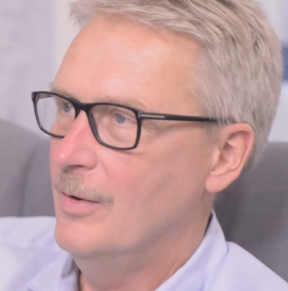 Mikael Lundahl works with language processes and language technology. From content creation to translation and publishing. From marketing material to technical documentation and software strings. His focus is on how terminology, with processes and tools, can support both the writing and translation processes.
Fodina Language Technology partners with and sells products from Kaleidoscope and Acrolinx. But Fodina also develops tools that help customers to build their company terminologies based on existing documentation, standards, or competitor's web information. AI-supported term extraction from many file formats and automated clustering of identified terms into concepts. Through integrations to both Acrolinx and Kaleidoscope products, we have full tool support for the terminology process that we recommend customers to use. Our tools support working with terms in English, German, and Swedish.
Mikael Lundahl works with language processes and language technology. From content creation to translation and publishing. From marketing material to technical documentation and software strings. His focus is on how terminology, with processes and tools, can support both the writing and translation processes.
Fodina Language Technology partners with and sells products from Kaleidoscope and Acrolinx. But Fodina also develops tools that help customers to build their company terminologies based on existing documentation, standards, or competitor's web information. AI-supported term extraction from many file formats and automated clustering of identified terms into concepts. Through integrations to both Acrolinx and Kaleidoscope products, we have full tool support for the terminology process that we recommend customers to use. Our tools support working with terms in English, German, and Swedish.
-
Recorded on November 3, 2022
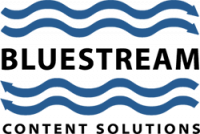 For over fifteen years, teams have tried to justify their need for a move to structured content with the same old arguments. In today’s ever-changing landscape, these old arguments are no longer sufficient and, in many cases, not even relevant. In this webinar, we will be looking at other drivers for the move to structure with real-world examples of what can be achieved.
Presented by Rik Page, Bluestream
For over fifteen years, teams have tried to justify their need for a move to structured content with the same old arguments. In today’s ever-changing landscape, these old arguments are no longer sufficient and, in many cases, not even relevant. In this webinar, we will be looking at other drivers for the move to structure with real-world examples of what can be achieved.
Presented by Rik Page, Bluestream
 Rik has worked with component content and document management solutions for over 20 years. He has worked with custom DTDs and Schemas, S1000D, iSpec2200, and DITA, together with various document and content management systems, including Documentum, SharePoint, XDocs, Ixiasoft, easyDITA, Astoria, and Vasont.
His practical experience ranges from high-volume data capture and content creation to dynamic multichannel delivery in various industries, including banking and finance, manufacturing, central government, and education. In addition, Rik has participated in multiple consultancy projects and helped formulate innovative solutions throughout Europe and North America.
Rik is also an advocate of Documentation 4.0, a new concept reflecting the demands on content/documentation that results from moving to Industry 4.0 and ‘smart’ manufacturing.
Rik has worked with component content and document management solutions for over 20 years. He has worked with custom DTDs and Schemas, S1000D, iSpec2200, and DITA, together with various document and content management systems, including Documentum, SharePoint, XDocs, Ixiasoft, easyDITA, Astoria, and Vasont.
His practical experience ranges from high-volume data capture and content creation to dynamic multichannel delivery in various industries, including banking and finance, manufacturing, central government, and education. In addition, Rik has participated in multiple consultancy projects and helped formulate innovative solutions throughout Europe and North America.
Rik is also an advocate of Documentation 4.0, a new concept reflecting the demands on content/documentation that results from moving to Industry 4.0 and ‘smart’ manufacturing.
-
November 11, 2021 Content authors need to consider many factors while converting their existing content to structured content, including analyzing the content at its source. This exercise is interesting yet challenging, vexing, but rewarding. But what are those factors you need to think about for this conversion? For starters, you need to consider:
- Character styles and how they are assigned (Use the style named Emphasis? Press Ctrl+I? Use a toolbar icon? Is there a difference?)
- Paragraph styles and how they are assigned (Did you skip bullet 1 and go right to bullet 2 because it looks better and, if you did, what does it mean?)
- Images and how to import them (Did you copy/paste or use the import setting? If so, how did you import it? As a link to the source?)
- Links between files or the web (Did it just get typed in, or was this inserted using a linking tool? How will it convert?)
- Page layout, tables, design, variables, equations, and so on
-
Recorded on December 15, 2022
 The new 20s have been very turbulent so far, and have shaken many basic beliefs in the industry. It might seem comforting to know that at least Component Content Management Systems still work just as reliably as they did back in 2019, 2014, or 2008... wait. Isn’t it time for a change? Experts agree that even the latest trends like content delivery, ontologies, or the cloud won't bring about the change needed for software to evolve the way technical writers actually use it. If we question our basic assumptions on how a CCMS works, however, we might find some exciting new possibilities.
WHAT YOU'LL LEARN
An industry expert will highlight the megatrends of the 20s and try to draw new conclusions for CCMSs. And no matter where this webinar will lead us, we'll have plenty of material for discussion at the end.
Presented By Sebastian Göttel
The new 20s have been very turbulent so far, and have shaken many basic beliefs in the industry. It might seem comforting to know that at least Component Content Management Systems still work just as reliably as they did back in 2019, 2014, or 2008... wait. Isn’t it time for a change? Experts agree that even the latest trends like content delivery, ontologies, or the cloud won't bring about the change needed for software to evolve the way technical writers actually use it. If we question our basic assumptions on how a CCMS works, however, we might find some exciting new possibilities.
WHAT YOU'LL LEARN
An industry expert will highlight the megatrends of the 20s and try to draw new conclusions for CCMSs. And no matter where this webinar will lead us, we'll have plenty of material for discussion at the end.
Presented By Sebastian Göttel
 Sebastian Göttel is Head of Marketing and Product Management at Quanos Content Solutions GmbH. The computer scientist has been involved with XML editing systems and content delivery since 1998. In the Tekom environment, he worked on version 1.0 of the iiRDS standard. [email protected]
Sebastian Göttel is Head of Marketing and Product Management at Quanos Content Solutions GmbH. The computer scientist has been involved with XML editing systems and content delivery since 1998. In the Tekom environment, he worked on version 1.0 of the iiRDS standard. [email protected]
-
February 15, 2022 Just putting your technical documentation on your webpage as a PDF for download will not make you a content hero. PDF is a given – a fundamental requirement. However, both business leaders and end customers expect more than just a documentation portal or a well-designed PDF. They want contextually relevant, personalized, consistent, conversational, and scalable content experiences. But how to deliver on this expectation? In this session, Stefan Gentz, Senior Worldwide Evangelist for Technical Communication at Adobe, will share some insights from the recent Adobe-commissioned Forrester study. Forrester surveyed 450 decision-makers on Content Experience Management to understand how global brands deliver relevant and contextual experiences across touchpoints. He will explore the design of positive customer journeys from marketing to technical support and self-service and back to sales – experiences that provide 360° content experience for your customers and handhold them across their whole content journey. Presented by: Stefan’s mission is to inspire enterprises and technical writers around the world and show how to create compelling technical communication content with the Adobe Technical Communication tools. He is also a certified Quality Management Professional (TÜV), ISO 9001 / EN 15038 auditor, ISO 31000 Risk Management expert, and Six Sigma Champion. As a sought-after keynote speaker and moderator at conferences around the world, he travels around the globe half of the year. Besides that, he has been the European Ambassador for the Globalization and Localization Association (GALA) for many years, a member of the tekom Conference Advisory Board for several years, and is now a member of the tekom iiRDS working group for Intelligent Information and member of the OASIS DITA Adoption Committee. In 2016, Stefan Gentz was awarded by MindTouch as one of the Top 25 Leading Content Strategist Influencers in the world and as one of the Top 25 Content Experience Influencers in the world in 2017. Stefan Gentz on LinkedIn Stefan Gentz on XING @stefangentz on Twitter www.adobe.com
-
Recorded on April 6, 2023

Enterprise companies are adopting AI generative tools to streamline their content operations and improve efficiency. But without proper governance, they may find themselves publishing off-brand, non-compliant, and even offensive content.
In the era of generative AI, companies need content governance more than ever. Join Paul Bongers to take a closer look at ChatGPT, AI, and NLP technologies and discuss their impact. Don’t miss out on this unique opportunity to balance innovation and governance in the digital age.
Come learn:
-
How generative AI works
-
Its opportunities and pitfalls
-
Where it fits in the content supply chain
-
Why it requires content QA and governance
 Paul Bongers is a strategist, technologist, and a SaaS generalist. In his role as VP Strategy, Paul shapes the Acrolinx product strategy. His team works closely with all departments across the business to foster innovation and expand value for Acrolinx customers.
LinkedIn: https://www.linkedin.com/in/pbongers/
Paul Bongers is a strategist, technologist, and a SaaS generalist. In his role as VP Strategy, Paul shapes the Acrolinx product strategy. His team works closely with all departments across the business to foster innovation and expand value for Acrolinx customers.
LinkedIn: https://www.linkedin.com/in/pbongers/
-

